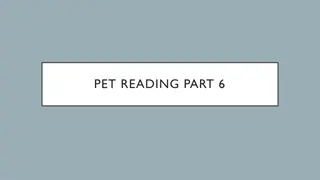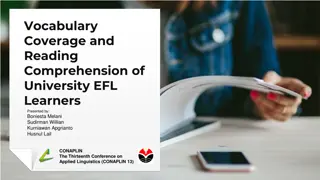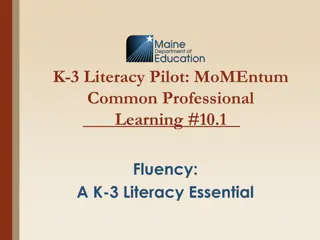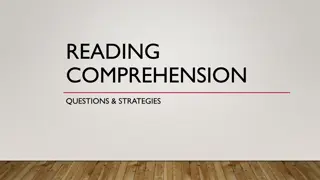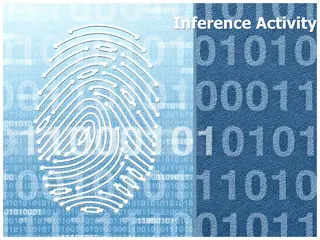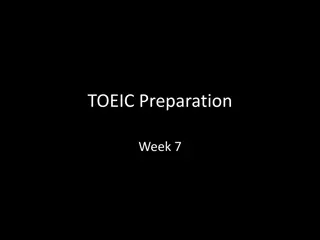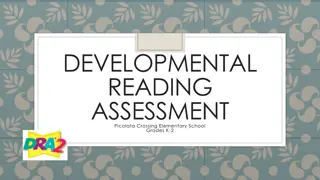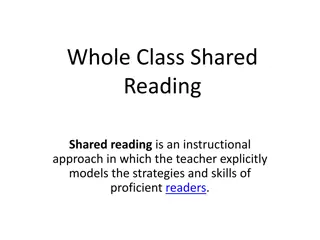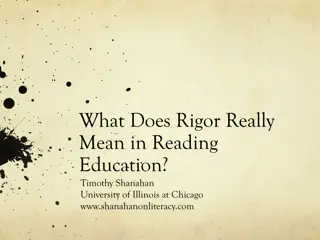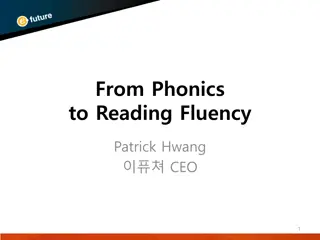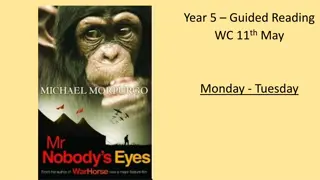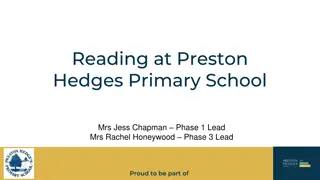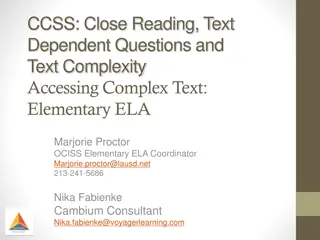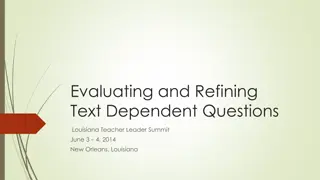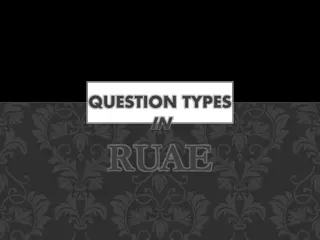Enhancing Reading Comprehension Through Text-Dependent Questions
This resource delves into the significance of text-dependent questions in improving students' reading comprehension skills by emphasizing the importance of evidence from the text, building knowledge through nonfiction, and developing critical thinking abilities. It highlights key advances in education prompted by CCR standards, focusing on text complexity, evidence-based reading and writing, and content-rich nonfiction. The content stresses the need for students to make valid claims supported by textual evidence, providing practical implications and guidance for educators on incorporating text-dependent questions effectively within their instructional strategies.
Download Presentation

Please find below an Image/Link to download the presentation.
The content on the website is provided AS IS for your information and personal use only. It may not be sold, licensed, or shared on other websites without obtaining consent from the author. Download presentation by click this link. If you encounter any issues during the download, it is possible that the publisher has removed the file from their server.
E N D
Presentation Transcript
Identifying Questions Worth Answering Foundational Unit 3 Produced Under U.S. Department of Education Contract No. ED-VAE-13-C-0066 With StandardsWork, Inc. 2016
Three Key Advances Prompted by the CCR Standards 1. Text Complexity: Regular Practice With Complex Text (and Its Academic Language) 2. Evidence: Reading and Writing Grounded in Evidence From Text 3. Building Knowledge: Building Knowledge Through Content-Rich Nonfiction 2
Key Advances Build Toward College and Career Readiness 3
Unit 3 Objectives Identifying Questions Worth Answering Develop an appreciation for text-dependent questions as a powerful tool in activating students ability to focus carefully on a text. Learn how good questions help students collect the evidence they need to support their claims and conclusions about text(s) they are reading. Practice identifying questions about an authentic text to learn how text-dependent questions inform instruction. 4
Rationale for Focusing on Evidence From Text Relevance and Importance Based on the Research Most college and workplace writing requires evidence (surveys from postsecondary faculty and employers). The ability to cite evidence differentiates strong from weak student performance on national assessments. The ability to locate and deploy evidence is a hallmark of strong readers and writers. 5
Implications of Focusing on Textual Evidence on Instruction Require students to make valid claims that square with text evidence. Ask questions that do not require information or evidence from outside the text. Include effective sequences of questions that build on one another so students stay focused on the text. Substitute text-dependent questions for non-text-dependent questions in textbooks. 6
Defining Text-Dependent and Text-Specific Questions Text-dependent questions push students to rely solely on the text for insight and analysis. They require reliance on the language and mechanics of the text itself, rather than personal experience or opinion. Questions probe the specifics of the text and avoid canned questions that could be asked of any text. Simply put, text-dependent questions identify the text as the expert in the room. 7
Non-Text-Dependent Text-Dependent In Casey at the Bat, Casey strikes out. Describe a time when you failed at something. What makes Casey s experiences at bat humorous? What can you infer from King s letter about the letter that he received? In Letter From a Birmingham Jail, Dr. King discusses nonviolent protest. Discuss a time when you wanted to fight against something that you felt was unfair. Why does Tom hesitate to allow Ben to paint the fence? How does Twain construct his sentences to reflect that hesitation? What effect does Tom s hesitation have on Ben? From The Adventures of Tom Sawyer, identify the different methods of removing warts that Tom and Huck talk about and devise your own charm to remove warts. Are there cultural ideas or artifacts from today that could be used in the charm? 8
How to Construct a Strong Question Set Investigate the qualitative features of the text. Identify the key ideas of the text. Start small to build confidence and check understanding. Target vocabulary and text and sentence structure. Tackle tough sections head-on. Create coherent sequences of text-dependent questions. Identify the standards that are being addressed. Create a culminating assessment by referring back to the core understanding or key ideas. 9
Hands-On Practice Now let s do some work identifying questions worth answering . . . 10
Materials Directions for Participants Worksheet: Identifying Questions Worth Answering: The Words We Live By: Your Annotated Guide to the Constitution Resource: Excerpt from The Words We Live By: Your Annotated Guide to the Constitution Worksheet: Identifying Questions Worth Answering: Eleanor Roosevelt Speaks to the Members of the American Civil Liberties Union Resource: Eleanor Roosevelt Speaks to the Members of the American Civil Liberties Union 11
Directions 1. Refer to your copies of The Words We Live By: Your Annotated Guide to the Constitution. 2. Review Identifying Questions Worth Answering and coding guides. 3. Reread the excerpt from The Words We Live By. Stop for a moment to consider as a group what understanding Monk wants to communicate in this excerpt. 4. Evaluate a couple of the questions together, applying the first category (i.e., Y/N: Could a student find evidence in the essay to answer this question?). 12
Directions (Continued) 5. Continue to apply the first category to the remaining questions. 6. Evaluate a couple of the questions together, applying the second category (i.e., D: Does a reader have to dig deep to answer this question?). 7. Finish evaluating all of the remaining questions with that category, noting any questions or confusion to address in the debrief discussion with participants at your table. 8. Repeat the evaluation of questions, applying the next two categories (i.e., V: Does the question ask about a vocabulary word in the essay? *: Is this a question worth asking? If not, could you revise it to make it worth asking?). 13
Directions (Continued) 9. During the debrief discussion, share your answers to the different columns with other table members and discuss any points of agreement or disagreement. Talk about which questions were the most difficult to analyze and why. 10. After you finish the exercise, talk with your full table again about what is the enduring understanding (the big idea) of the excerpt. Discuss whether any one of the questions is asking about that big idea, and note it at the bottom of the worksheet. 11. Now repeat the exercise for the second resource: Eleanor Roosevelt Speaks to the Members of the American Civil Liberties Union. Work Sessions 1 and 2 45 minutes each 14
Reflections Would the questions from Monk s essay ask students to probe deeply into the text and read carefully to arrive at a solid answer? Would the questions from Roosevelt s speech ask students to probe deeply into the text and read carefully to arrive at a solid answer? Would students have to return to the text and read it carefully to answer the question? How would that set of behaviors strengthen students reading comprehension? 20 minutes 15
Next Steps How has participating in this activity changed your thinking about the CCR Standards? How will you use the information and understanding you have acquired to improve your teaching practice and student learning? What additional training and tools would strengthen your ability to do so? 16







